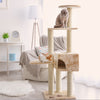How to DIY Your Own Cat Toys
- by Rufus and Coco
Cat toys aren’t the most expensive type of accessories that you might have to purchase for your pet. But like any other animal, cats tend to get bored of their toys every once in a while.
One way of avoiding to constantly buy new toys for your cat is rotating between them. This means allowing your cat to play with one for 1 to 2 weeks, then hiding it and replacing it with another toy.
But if you want to put your creativity and handy skills to work and DIY some cat toys, here are some of our favourites!
5 Cat Toys That You Can Do Yourself
Every item that you might leave around can be a toy in itself, especially if you are caring for kittens.
Their playfulness will activate on every occasion, so there’s no need for you to do a lot of work and create overly complicated toys for them. But if you do have enough time and want to make the most of whatever you have lying around the house, here are some of our suggestions.
Cardboard toy
Whether you turn it into a ball or a mouse-looking toy, the cardboard that’s left from using toilet paper can provide your pet with hours of entertainment. You can get the template on any site, such as Instructables, but the point is that you can use anything from a needle and thread to glue.
However, any adhesive or glue needs to be clearly marketed as non-toxic. Cats tend to nibble on their toys as if they were playing with actual prey, so all the supplies you use for your cardboard toys need to be pet-safe.
Sock toy
Mismatched socks are a part of being a human these days -- who hasn’t come across one that doesn’t seem to have a pair anymore? Well, you shouldn’t throw it away as with the right tools, it can be a great toy for your cat.
You can fill a sock with your cat’s favourite treats, which would make the task of getting to them a bit challenging. This can be particularly helpful for cats who tend to eat too much when you’re out of the house as they will have to make an effort instead of having food always at their disposal.
Of course, socks can also be filled with catnip, and if you didn’t know, catnip can now be bought separately. Most catnip toys these days come with zippers so you can replace the herbs and get your pet to be interested in them again.
Cat wand toy
A cat wand doesn’t call for too much time and effort, and the best thing about making one is that you can use a variety of materials that you might already have in your home. Feathers aren’t the only things that will grab your cat’s attention -- you can use thin pieces of differently coloured fabric, instead.

The best way to build the wand is to use the remnants of one that your pet has already destroyed. Chances are that at the end of the wooden piece there will be a hole where you can make a yarn knot and attach whatever you feel your cat might like most -- even a jingle bell can work if your kitty likes playing with toys that make a bit of noise.
Wine cork toys
Although they might not be the first thing that comes to mind in terms of DIY kitty toys, wine corks can make some adorable accessories.
You do have to boil them before working with them, though, since most are hard so instead of being able to staple or stitch anything to them, you might destroy them altogether.
You can also use epoxy or pet-safe glue to attach feathers, yarn, or whatever else you think will keep your cat busy for several hours. And just to be on the safe side, wait for half a day after applying the glue to the wine cork to make sure that it’s completely dry.
Felt mouse toy
For this homemade cat toy, you will need a glue gun, a pair of scissors, a needle and thread, some cotton balls, and catnip (although this one is completely optional). Cut your felt fabric pieces into shapes and then blanket stitch halfway through the top of the mouse to-be.
Then you can blanket stitch the bottom, fill it with your stuffing of choice, and then stitch everything together. If you’d like your mouse toy to be perfect, you can stitch its tail inside -- you can use twine for the purpose. Once everything’s done, all you have to do is sew the felt ears so that the toy looks like a tiny rodent.

You can throw the mouse around for a nice game of catch if that’s what your cat likes, or you can stitch it to the end of a wand toy that you’ve used before.
Safety precautions
We already mentioned that all of the supplies you should use for your DIY cat toys have to be completely pet-safe, but there are several other things to keep in mind.
Inspect your toys on a regular basis to make sure that your cat doesn’t risk ingesting a lot of cardboard, rope, or even the plush or cotton balls you might have used for stuffing.
In case you didn’t know, not only can these pose a choking hazard, but they can also lead to intestinal blockages. The last thing you probably want is to have an unwanted visit to the vet clinic.
Some examples of materials that should be avoided when making DIY cat toys are paper clips, elastic yarn, plastic bags, and anything that’s small enough for your pet to be able to swallow.
Last, but not least, toys can be germ carriers, especially if you do not clean them at least once a week. Your cat’s mouth already contains enough microorganisms, even Staphylococcus spp., but if you leave your pet’s toys around, they’ll gather dust and debris and could collect other germs from your floors, too.
- Posted in:
- cat
- cats
- fun
- how to help
- tips





